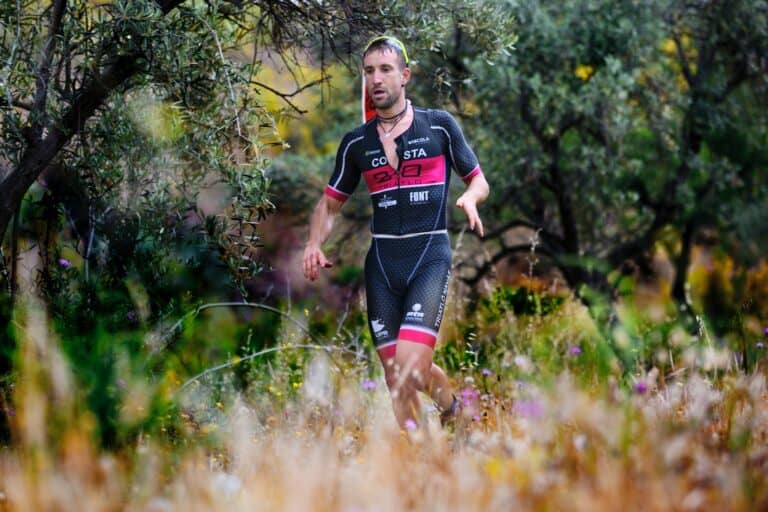In the ever-busy world we live in, finding time to prioritize fitness and exercise can be a challenge. However, there’s a solution that not only keeps you in top shape but also maximizes your time – trail running.
In this blog post, we’ll delve deep into the world of trail running and its remarkable time efficiency. We’ll explore how various physiological and biomechanical factors impact your performance as a trail runner and discuss the critical role that body composition plays in your journey towards becoming a top-notch trail runner.
Understanding Trail Running and Time Efficiency

Trail running is a physically demanding sport that combines cardiovascular endurance with the thrill of navigating technical trails. This unique blend offers a myriad of benefits, but one that truly stands out is its ability to fit into even the busiest of schedules.
- Trail Running vs. Traditional Running (Trail Running): Unlike the monotony of traditional running, trail running injects excitement into your workout. The ever-changing terrain and stunning scenery make each run a fresh adventure, ensuring you stay motivated and fit your workouts into your busy schedule.
- Trail Running Performance (Trail Running Performance): Trail running isn’t just about distance; it’s about conquering diverse terrains. From endurance to agility, this section delves into the various facets of trail running performance, equipping you with the skills needed to make the most of your time on the trail.
- Trail Runners: A Unique Breed (Trail Runners): Trail runners are a different breed, driven by passion and commitment. Discover how this community embraces time-efficient training, making the most of every moment, and turning the trail into a lifestyle.
The Role of Body Composition in Trail Running
Understanding your body composition is crucial when it comes to excelling in trail running.
- Body Mass Index and Trail Running (Body Mass Index): Your Body Mass Index (BMI) is a key metric that impacts your trail running performance. While a high BMI might not be detrimental to everyone, it can be a factor to consider when navigating the trails. Individuals with a higher BMI might find trail running more challenging due to the extra load.
- Body Composition and Athletic Performance (Performance and Body Composition): Beyond BMI, your overall body composition plays a significant role in your athletic performance as a trail runner. We’ll discuss the importance of finding the right balance between fat mass and lean body mass. A well-balanced body composition can enhance your agility, endurance, and overall efficiency on the trail.
- Fat Mass and Lean Body Mass (Lean Body Mass): The composition of your body, particularly the distribution of fat mass and lean body mass, can be a game-changer in trail running. Lean body mass, which includes muscle, contributes to strength and endurance, while a lower fat mass percentage is desirable for enhanced agility.
The Science Behind Trail Running Performance
In the quest for peak performance in trail running, it’s essential to explore the physiological and biomechanical factors that come into play.
- VO2 Max and Its Impact (VO2 Max): In the world of trail running, your VO2 max is a critical factor that can make a significant difference in your performance. VO2 max, or maximal oxygen consumption, represents the maximum amount of oxygen your body can utilize during intense exercise. For trail runners, a higher VO2 max translates to improved endurance, allowing you to sustain those uphill slogs and rugged terrains without tiring out quickly. It’s the engine that powers your aerobic capacity and sets the stage for your trail running success. Training methods that boost your VO2 max, such as interval training and hill sprints, are essential for every trail runner looking to enhance their time efficiency and endurance.
- The Energy Cost of Running (Energy Cost): Running economy is a term often discussed in the context of trail running and it plays a pivotal role in optimizing your time efficiency. It refers to the amount of energy expended while running at a specific pace. The more efficient your running economy, the less energy you waste on each stride, allowing you to maintain higher speeds and prolong your runs. Improving your running economy involves fine-tuning your running form, making sure each step is as efficient as possible. As a trail runner, this efficiency can be a game-changer, especially when tackling challenging terrains that demand extra energy. By focusing on your running economy, you not only become a more efficient runner but also maximize the benefits of trail running for your busy schedule.
- Muscle Mass and Performance (Muscle Mass): Trail running is as much about strength as it is about endurance. Having adequate muscle mass is essential for handling steep ascents, descents, and the uneven terrain commonly encountered on trails. Strong leg muscles, in particular, are vital for stability and power. As you build and maintain your muscle mass, you’re equipping yourself with the tools needed to tackle physically demanding uphill runs and technical trail sections. Furthermore, muscle mass contributes to your overall body composition, which can influence your running performance. Striking the right balance between muscle and lean body mass ensures that your trail running is not just time-efficient but also highly effective in terms of your physical capabilities.
Training and Testing for Trail Running Success
To maximize your time and potential as a trail runner, you need a structured approach to training.
- Optimal Training Programs (Training Program): The cornerstone of trail running success lies in crafting the right training program. Optimal training programs for trail running are tailored to your unique goals, fitness level, and the time you have available. These programs incorporate a mix of distance runs, hill sprints, and trail-specific exercises to enhance your strength, endurance, and agility. By customizing your training plan, you ensure that your workouts are both time-efficient and effective. The key is striking a balance between pushing your limits and allowing for sufficient recovery, creating a regimen that maximizes your potential on the trail.
- Graded Exercise Testing (Graded Exercise Test): Graded exercise tests are invaluable tools for trail runners seeking to monitor their progress and set realistic goals. These tests involve systematically increasing the intensity of your workout, whether through elevation, speed, or duration. By undergoing graded exercise testing, you gain insight into your physical capabilities, such as your VO2 max, lactate threshold, and aerobic capacity.This information is instrumental in fine-tuning your training program and optimizing your time on the trail. As a trail runner, understanding your physical limits and potential is the key to efficient training and continuous improvement.
- Trail Running and the Long Haul (Long Distance Running Performance): While trail running is often associated with shorter, more intense races, it also has a significant impact on long-distance running performance, including marathons and ultra-marathons. The skills you develop on the trail, such as pacing, endurance, and mental resilience, translate seamlessly to longer races. Incorporating trail running into your training can break the monotony of road running and provide a dynamic challenge for your body. It’s a testament to the versatility of this sport; whether you’re aiming for a speedy 10K or an arduous ultra-marathon, trail running can significantly enhance your long-distance running performance.
Trail Running for Busy Schedules: Your Time-Efficient Workout Solution

Trail running is all about making the most of your available time. Unlike traditional workouts that require a fixed schedule and a specific location, trail running offers flexibility. You can hit the trail when it suits you, whether it’s a quick morning run before work or a rejuvenating evening jog to unwind. This adaptability allows you to seamlessly integrate exercise into your daily routine without the constraints of a gym’s operating hours.
Moreover, trail running offers the advantage of combining exercise with the great outdoors. It’s a multi-sensory experience where you’re not just running; you’re connecting with nature. This unique blend of physical activity and natural beauty can be a refreshing escape from the concrete jungle, reducing stress, enhancing mental well-being, and making every run feel like a mini-adventure.
The Science Behind Endurance and Performance

Endurance Running Performance: Trail running isn’t just about a leisurely jog; it’s a high-performance sport. Trail running can significantly impact your endurance running performance, giving you an edge in longer races like marathons.
Peak Treadmill Running Velocity
Within the realm of trail running, speed plays a pivotal role in determining your success. Your peak treadmill running velocity is a secret weapon that can revolutionize your trail race performance. By honing this aspect of your training, you can significantly impact your trail racing abilities. This focus on speed not only helps you navigate technical terrain more efficiently but also enhances your capacity to maintain pace and surge when necessary during a race.
Unlocking Your Competitive Edge
Trail running isn’t just about endurance; it’s also about the ability to adapt to changing terrains and situations swiftly. Your peak treadmill running velocity contributes to your overall running economy, making your trail running experience smoother and more efficient. The techniques we discuss in this section will enable you to tackle technical trails with greater ease while maintaining your speed.
By improving your top-end velocity, you’ll be better equipped to navigate the undulating landscapes, ascend steep hills, and tackle the demanding downhill sections, ensuring you not only keep up with the trail but stay ahead in the race. Your time-efficient trail running journey gets an essential boost when you harness the power of speed, and we’ll guide you through every step of this exhilarating transformation.
Physiological and Biological Factors
An intimate connection exists between the sport and the field of sports medicine. This symbiotic relationship highlights the critical importance of understanding the physiological and biological factors that underpin your trail running capabilities. By exploring this nexus, we delve deep into the intricate interplay between your body’s physiological responses and your biological makeup.
This knowledge equips trail runners with profound insights into how their unique physical characteristics, such as muscle mass, aerobic capacity, and VO2 max, influence their performance. It offers a roadmap to harness these factors, optimizing training strategies and ultimately elevating trail running prowess. Understanding the nuanced interrelationship between your body and the sport is pivotal in unlocking your full potential as a trail runner.
Predicting Endurance Running Performance
Predicting one’s endurance running performance is a prized skill for trail runners. In this section, we venture into the methodologies and tools that empower trail enthusiasts to gauge their capabilities accurately. By doing so, trail runners can set realistic, attainable goals that align with their fitness levels and aspirations. The ability to track and measure progress efficiently is paramount, and we explore the diverse metrics and techniques available, enabling you to keep a vigilant eye on your improvement.
Trail Races and the Uphill Challenge

Trail races are the ultimate test for trail runners. These events are not your typical races; they take your trail running skills to the next level. They unfold on diverse terrains, from rugged mountain trails to dense forests, providing a challenging backdrop that pushes your physical and mental limits. The variety of obstacles you encounter on these trails, from steep ascents to creek crossings, demands adaptability and resilience.
The uphill challenge, in particular, is a defining aspect of trail races. Ascending steep slopes, often with uneven footing, is where your endurance, strength, and technique are put to the test. It’s not just about conquering the physical obstacles; it’s about conquering yourself.
Trail races become a thrilling journey of self-discovery, where you learn to harness your inner strength and push beyond your perceived limits. These races epitomize the essence of trail running – an adventure where every stride is an exhilarating challenge and a triumph over the uphill hurdles is a testament to your dedication and resilience.
Evaluate Endurance Mountain Runners
Endurance mountain runners are the epitome of endurance. These athletes take on some of the most grueling and challenging races in the world. They navigate steep, rocky terrain, tackle extreme altitudes, and endure long hours of relentless running. What sets endurance mountain runners apart is their exceptional ability to maintain peak performance over extended periods.
To evaluate endurance mountain runners, it’s crucial to look at their training regimens, mental toughness, and the physiological adaptations that allow them to conquer such demanding courses. These runners often incorporate specialized workouts that simulate the harsh conditions they’ll face in races, such as uphill sprints and high-altitude training.
Their mental resilience is equally impressive, as they must overcome fatigue and harsh environmental conditions to reach the finish line. By studying endurance mountain runners, we can gain valuable insights into the limits of human endurance and apply some of their techniques to our own trail running routines.
Short Trail Running Races: A Fast Track to Marathon Performance
Short trail running races, often overlooked but immensely valuable, can be the catalyst for enhanced marathon running performance. These high-intensity events provide an ideal platform to push your limits and fine-tune your skills.
By participating in short trail races, you not only inject excitement into your training regimen but also build essential attributes like speed, agility, and the mental fortitude required to excel in marathon running. These quick-paced races serve as stepping stones to your marathon goals, enabling you to break through performance plateaus and reach new heights.
Short Trail Running Performance and Marathon Success
Incorporating short trail races into your training schedule is akin to sharpening the blade before tackling a marathon. The intensity of these races not only strengthens your running prowess but also hones your endurance, allowing you to sustain peak performance throughout a marathon. The swift, challenging terrain of short trail races cultivates adaptability, a skill that is invaluable when facing the unpredictable nature of a marathon course.
These races infuse variety into your training routine, breaking the monotony that can hinder progress. In essence, short trail running races become the crucible in which marathon runners are forged, and the performance improvements witnessed in both short and long distances are symbiotic, making every stride count in your journey towards marathon excellence.
Final Thoughts: Trail Running and Time Efficiency
In conclusion, trail running is not just a sport but a lifestyle that offers time efficiency and a range of health benefits. By understanding the impact of body composition, physiological factors, and time-efficient training, you can truly maximize your potential as a trail runner. Whether you’re a seasoned athlete or just getting started, this comprehensive guide has provided you with the knowledge and insights needed to embark on a fulfilling trail running journey.
Remember, the trail is waiting, and your time is valuable. So, lace up your running shoes, embrace the adventure, and let trail running lead you to peak fitness and time efficiency like never before.
- Trail Running And Ankle Strength
- Trail Running And Camping
- Trail Running And Confidence
- Trail Running And Creativity
- Trail Running And Ecotherapy
- Trail Running And Longevity
- Trail Running And Mental Health
- Trail Running And Sun Protection Tips
- Trail Running And Time Efficiency
- Trail Running And Wildlife
- Trail Running At Night
- Trail Running Clothing
- Trail Running Etiquette Dos And Donts
- Trail Running Etiquette With Dogs
- Trail Running For Charity
- Trail Running For Families
- Trail Running For Rehabilitation After Injury
- Trail Running For Stress Relief
- Trail Running For Weight Loss
- Trail Running Gear For Beginners
- Trail Running In Different Altitudes
- Trail Running In Different Weather Conditions
- Trail Running In Remote Locations
- Trail Running On A Budget
- Trail Running Photography
- Trail Running Recovery Techniques
- Trail Running Safety Tips For Beginners
- Trail Running Snacks
- Trail Running Techniques To Boost Your Pace
- Trail Running Tips
- Trail Running With Dogs
- Trail Running With Kids
- Trail Running With Physical Disabilities
- Is Trail Running A Good Workout
- Is Trail Running An Extreme Sport Unraveling The Truth
- Is Trail Running Bad For Your Knees
- Is Trail Running Better Than Road Running
- Is Trail Running Good For Dogs
- Is Trail Running Good For Marathon Training
- Is Trail Running The Same As Cross Country
